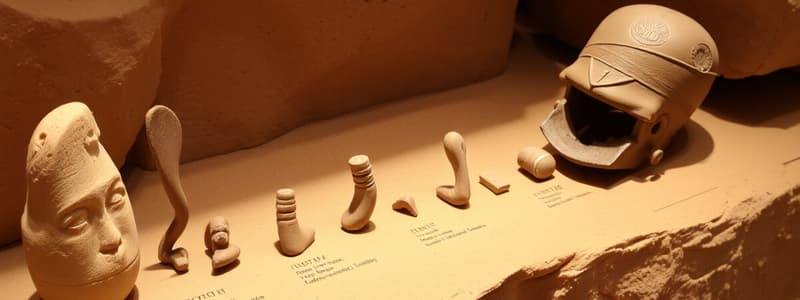Podcast
Questions and Answers
What primary need did early humans address with their tools?
What primary need did early humans address with their tools?
- Development of written communication
- Construction of permanent shelters
- Transportation of goods
- Necessities for survival such as hunting and gathering (correct)
What do the terms 'Paleolithic' and 'Neolithic' primarily refer to?
What do the terms 'Paleolithic' and 'Neolithic' primarily refer to?
- Different periods in human technological development (correct)
- Types of climate in the ancient world
- Geographical locations of early civilizations
- Different types of human species
Why do scientists rely on fossils and artifacts when studying early humans?
Why do scientists rely on fossils and artifacts when studying early humans?
- Because there are no written records from prehistoric times (correct)
- To determine human dietary preferences
- To understand agricultural practices
- To gain insights from written records
What location is considered to be the origin of early humans?
What location is considered to be the origin of early humans?
Which of the following tools might have been used by early humans for hunting?
Which of the following tools might have been used by early humans for hunting?
What characteristic of early toolmakers contributed to their ability to survive?
What characteristic of early toolmakers contributed to their ability to survive?
What is an artifact?
What is an artifact?
How did the geographical spread of early humans affect their tool-making?
How did the geographical spread of early humans affect their tool-making?
What geographic feature was crucial for the development of agricultural areas before 5000 B.C.?
What geographic feature was crucial for the development of agricultural areas before 5000 B.C.?
What was the population of Catal Huyuk at its peak?
What was the population of Catal Huyuk at its peak?
What type of houses were built in Catal Huyuk?
What type of houses were built in Catal Huyuk?
Which crops were predominantly cultivated in Catal Huyuk?
Which crops were predominantly cultivated in Catal Huyuk?
What material was utilized extensively for making tools and trade items in Catal Huyuk?
What material was utilized extensively for making tools and trade items in Catal Huyuk?
Which of the following best describes the cultural life in Catal Huyuk?
Which of the following best describes the cultural life in Catal Huyuk?
What role did agricultural surpluses play in Catal Huyuk?
What role did agricultural surpluses play in Catal Huyuk?
What religious structures were prevalent in Catal Huyuk?
What religious structures were prevalent in Catal Huyuk?
What fundamental change allowed larger populations to be supported in early settlements?
What fundamental change allowed larger populations to be supported in early settlements?
Which of the following best describes the transition from village life to city life?
Which of the following best describes the transition from village life to city life?
What impact did food surpluses have on early civilizations?
What impact did food surpluses have on early civilizations?
Which tool contributed significantly to improved farming efficiency in ancient settlements?
Which tool contributed significantly to improved farming efficiency in ancient settlements?
What was one consequence of the more complex social relationships as populations grew?
What was one consequence of the more complex social relationships as populations grew?
The gradual increase in population in early farming villages led to which of the following?
The gradual increase in population in early farming villages led to which of the following?
What primary factor enabled the shift from a nomadic lifestyle to settled village life?
What primary factor enabled the shift from a nomadic lifestyle to settled village life?
How did the emergence of craftwork influence early economies?
How did the emergence of craftwork influence early economies?
What is the estimated age range of the paintings at Cuevas de las Manos?
What is the estimated age range of the paintings at Cuevas de las Manos?
Why was the Lascaux cave closed to the public in 1963?
Why was the Lascaux cave closed to the public in 1963?
Which people created the paintings in Cuevas de las Manos?
Which people created the paintings in Cuevas de las Manos?
What feature of the Cuevas de las Manos cave structure is noted?
What feature of the Cuevas de las Manos cave structure is noted?
How is the visitor experience to Lascaux cave managed today?
How is the visitor experience to Lascaux cave managed today?
What is the approximate depth of Cuevas de las Manos?
What is the approximate depth of Cuevas de las Manos?
What type of artwork predominates in the Lascaux cave?
What type of artwork predominates in the Lascaux cave?
During which time period were the Lascaux cave paintings likely created?
During which time period were the Lascaux cave paintings likely created?
What was a key technological advance that allowed early humans to adapt better to their environment?
What was a key technological advance that allowed early humans to adapt better to their environment?
Which hominid group's achievements are considered most significant in human history?
Which hominid group's achievements are considered most significant in human history?
How did Neanderthals and Cro-Magnons differ from earlier human groups?
How did Neanderthals and Cro-Magnons differ from earlier human groups?
What can bones and artifacts reveal about early peoples?
What can bones and artifacts reveal about early peoples?
What aspect of early human customs is difficult to fully understand?
What aspect of early human customs is difficult to fully understand?
What major achievement was characteristic of the Paleolithic Age?
What major achievement was characteristic of the Paleolithic Age?
Which of the following was a primary focus during the Neolithic Age?
Which of the following was a primary focus during the Neolithic Age?
Why is the discovery of fire considered a turning point in human history?
Why is the discovery of fire considered a turning point in human history?
Flashcards are hidden until you start studying
Study Notes
Human Origins in Africa
- Early humans originated in Africa and gradually dispersed globally, supported by fossil evidence.
- Understanding early human remains and artifacts reveals insights into human history and evolution.
Early Human Tools and Survival
- Early humans crafted tools from materials like birch bark, stone, and metal for survival.
- Tools such as axes and daggers facilitated hunting, food preparation, and shelter building.
- Creativity and problem-solving were essential skills employed by early toolmakers.
Archaeological Discoveries
- Cave paintings, such as those in Cuevas de las Manos in Argentina, date back 13,000 to 9,500 years, showcasing early artistic expression.
- The Lascaux cave in France, discovered in 1940, features over 600 painted animals and symbols from 15,000-13,000 B.C.
Catal Huyuk
- Catal Huyuk, discovered in 1958, was a significant agricultural village located in present-day Turkey, thriving around 8,000 years ago.
- The village spanned 32 acres and supported 5,000 to 6,000 inhabitants living in interconnected brick houses.
- Rich agricultural land enabled the growth of crops such as wheat, barley, and peas, alongside the domestication of sheep and cattle.
Agricultural Revolution
- The agricultural revolution led to food surpluses, freeing individuals to develop specialized crafts.
- Increased agricultural productivity allowed settlements to support larger populations and complex social structures.
- Innovations in farming tools, like hoes and plows, significantly enhanced agricultural efficiency.
Cultural Development and Civilization
- Catal Huyuk is notable for its obsidian products, used to create trade items like mirrors and jewelry.
- Archaeological finds include vibrant murals depicting animals and hunting scenes, indicating a rich cultural life.
- Religious practices included shrines dedicated to a mother goddess, reflecting early spiritual beliefs.
Transition to Settled Life
- The shift from nomadic lifestyles to settled agriculture occurred gradually, resulting in more complex social relationships.
- Stable communities based on agriculture paved the way for the emergence of cities, marking the evolution of civilization.
- Advancements in irrigation and surplus production led to the rise of craftsmen and traders, expanding economic activities.
Studying That Suits You
Use AI to generate personalized quizzes and flashcards to suit your learning preferences.




